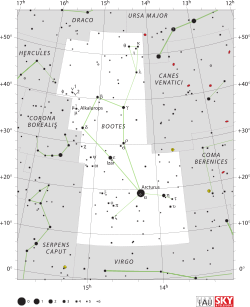Sigma Bootis
| Sigma Bootis (σ) | |
 | |
| Observationsdata Epok: J2000 | |
|---|---|
| Stjärnbild | Björnvaktaren |
| Rektascension | 14t 34m 40,81699s[1] |
| Deklination | +29° 44′ 42,4590″[1] |
| Skenbar magnitud () | 4,46[2] |
| Stjärntyp | |
| Spektraltyp | F4 Vk F2mF1[3] |
| U–B | -0,084[2] |
| B–V | +0,366[2] |
| R–I | 0,19 |
| Variabeltyp | Misstänkt[4] |
| Astrometri | |
| Radialhastighet () | +0,37 ± 0,09[5] km/s |
| Egenrörelse (µ) | RA: +188,35[1] mas/år Dek.: +131,77[1] mas/år |
| Parallax () | 63,16 ± 0,25[1] |
| Avstånd | 51,6 ± 0,2 lå (15,83 ± 0,06 pc) |
| Absolut magnitud () | +3,52[6] |
| Detaljer | |
| Massa | 1,48[7] M☉ |
| Radie | 1,431 ± 0,023[8] R☉ |
| Luminositet | 3,461 ± 0,042[5] L☉ |
| Temperatur | 6 594 ± 55[8] K |
| Metallicitet | -0,24[9] dex |
| Vinkelhastighet | 7,32[10] km/s |
| Ålder | 1,7[11] miljarder år |
| Andra beteckningar | |
| σ Boo, 28 Bootis, BD+30° 2536, GC 19659, GJ 557, HD 128167, HIP 71284, HR 5447, SAO 83416, CCDM 14347 + 2945 | |
Sigma Bootis (σ Bootis, förkortad Sigma Boo, σ Boo), som är stjärnans Bayer-beteckning, är en ensam stjärna i mellersta delen av stjärnbilden Björnvaktaren. Den har en skenbar magnitud av 4,46[2] och är synlig för blotta ögat där ljusföroreningar ej förekommer. Baserat på parallaxmätning inom Hipparcosuppdraget på ca 63,2 mas,[1] beräknas den befinna sig på ett avstånd av ca 52 ljusår (16 parsek) från solen.
Egenskaper[redigera | redigera wikitext]
Sigma Bootis är en vit till gul stjärna i huvudserien av spektralklass F4 Vk F2mF1.[3] Den har en massa som är omkring 50 procent[7] större än solens massa, en radie som är ca 1,4[5] gånger solens radie och avger ca 3,5[6] gånger mer energi än solen från dess fotosfär vid en effektiv temperatur på ca 6 600 K.[7] Stjärnan misstänks, liksom många andra av dess spektralklass, kunna vara en variabel av Delta Scuti-typ med flera olika variationsperioder i timskala.
Undersökningar med Spitzer och Herschels rymdteleskop kunde inte belägga ett överskott av infraröd strålning vid våglängder upp till 160 μm runt Sigma Bootis. HOSTS-undersökning med det stora dubbelteleskopet rapporterade dock en upptäckt av ett överskott i den fjärrinfraröda delen, vilket tyder på närvaro av exozodiakalt stoft nära stjärnens beboeliga zon.[12]
Se även[redigera | redigera wikitext]
Referenser[redigera | redigera wikitext]
- Den här artikeln är helt eller delvis baserad på material från engelskspråkiga Wikipedia, 16 april 2019.
Noter[redigera | redigera wikitext]
- ^ [a b c d e f] van Leeuwen, F. (2007), "Validation of the new Hipparcos reduction", Astronomy and Astrophysics, 474 (2): 653–664, arXiv:0708.1752, Bibcode:2007A&A...474..653V, doi:10.1051/0004-6361:20078357.
- ^ [a b c d] Elliott, J. E. (October 1974), "Study of delta Scuti variables", Astronomical Journal, 79: 1082–1090, Bibcode:1974AJ.....79.1082E, doi:10.1086/111657.
- ^ [a b] Gray, R. O.; et al. (April 2001), "The Physical Basis of Luminosity Classification in the Late A-, F-, and Early G-Type Stars. I. Precise Spectral Types for 372 Stars", The Astronomical Journal, 121 (4): 2148–2158, Bibcode:2001AJ....121.2148G, doi:10.1086/319956.
- ^ Samus, N. N.; Durlevich, O. V.; et al. (2009). "VizieR Online Data Catalog: General Catalogue of Variable Stars (Samus+ 2007-2013)". VizieR On-line Data Catalog: B/gcvs. Originally published in: 2009yCat....102025S. 1. Bibcode:2009yCat....102025S.
- ^ [a b c] Nidever, David L.; et al. (August 2002), "Radial Velocities for 889 Late-Type Stars", The Astrophysical Journal Supplement Series, 141 (2): 503–522, arXiv:astro-ph/0112477, Bibcode:2002ApJS..141..503N, doi:10.1086/340570.
- ^ [a b] Paunzen, E.; et al. (July 2014), "Investigating the possible connection between λ Bootis stars and intermediate Population II type stars", Astronomy & Astrophysics, 567: 8, arXiv:1406.3936, Bibcode:2014A&A...567A..67P, doi:10.1051/0004-6361/201423817, A67.
- ^ [a b c] David, Trevor J.; Hillenbrand, Lynne A. (2015), "The Ages of Early-Type Stars: Strömgren Photometric Methods Calibrated, Validated, Tested, and Applied to Hosts and Prospective Hosts of Directly Imaged Exoplanets", The Astrophysical Journal, 804 (2): 146, arXiv:1501.03154, Bibcode:2015ApJ...804..146D, doi:10.1088/0004-637X/804/2/146.
- ^ [a b] Boyajian, Tabetha S.; et al. (February 2012), "Stellar Diameters and Temperatures. I. Main-sequence A, F, and G Stars", The Astrophysical Journal, 746 (1): 101, arXiv:1112.3316, Bibcode:2012ApJ...746..101B, doi:10.1088/0004-637X/746/1/101. See Table 10.
- ^ Bensby, T.; et al. (2014), "Exploring the Milky Way stellar disk. A detailed elemental abundance study of 714 F and G dwarf stars in the solar neighbourhood", Astronomy & Astrophysics, 562 (A71): 28, arXiv:1309.2631, Bibcode:2014A&A...562A..71B, doi:10.1051/0004-6361/201322631.
- ^ Martínez-Arnáiz, R.; et al. (September 2010), "Chromospheric activity and rotation of FGK stars in the solar vicinity. An estimation of the radial velocity jitter", Astronomy and Astrophysics, 520: A79, arXiv:1002.4391, Bibcode:2010A&A...520A..79M, doi:10.1051/0004-6361/200913725.
- ^ Decin, G.; et al. (November 2003), "Age Dependence of the Vega Phenomenon: Observations", The Astrophysical Journal, 598 (1): 636–644, arXiv:astro-ph/0308294, Bibcode:2003ApJ...598..636D, doi:10.1086/378800
- ^ Ertel, S.; et al. (May 2018), "The HOSTS Survey—Exozodiacal Dust Measurements for 30 Stars", The Astronomical Journal, 155 (5): 19, arXiv:1803.11265, Bibcode:2018AJ....155..194E, doi:10.3847/1538-3881/aab717, 194.





